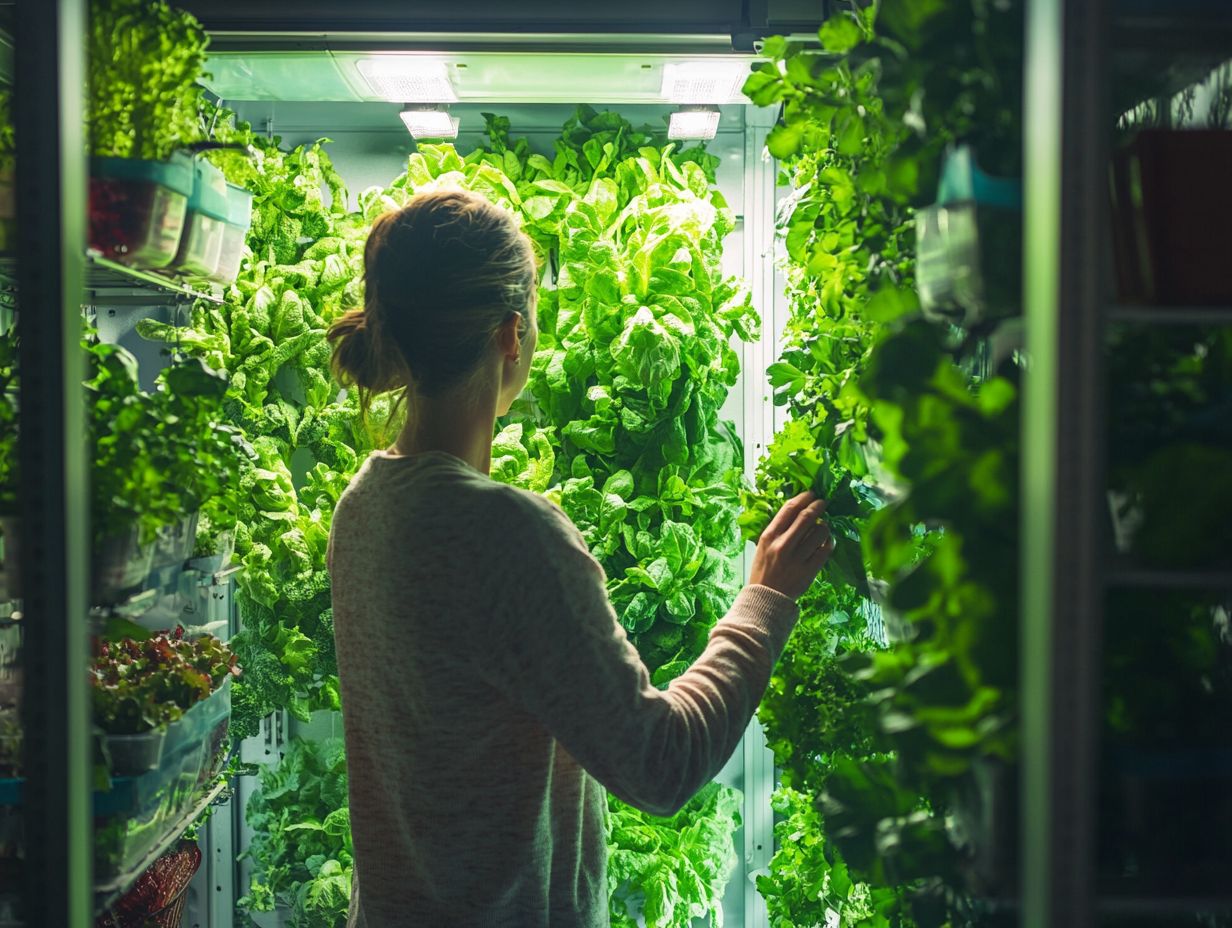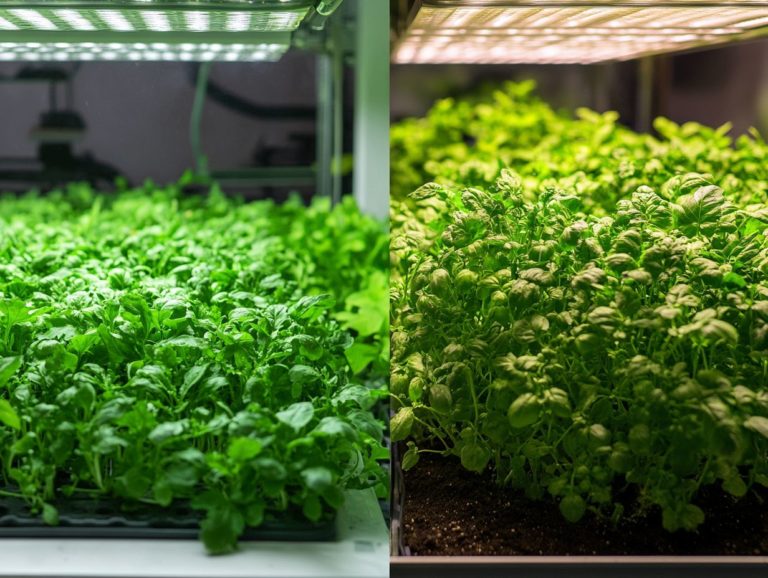What is Hydroponic Gardening?
Curious about hydroponic gardening? Imagine growing vibrant plants without any soil! That’s the magic of this innovative method of growing plants in a soil-free environment, which is rapidly gaining traction for its remarkable efficiency and effectiveness.
You ll explore the numerous advantages hydroponics has over traditional farming methods, dive into the science behind this groundbreaking technique, and examine the various hydroponic systems available for gardeners like yourself.
Whether you re a seasoned pro or just starting out, you ll discover essential tips to help you get going, troubleshoot common issues, and maintain a thriving hydroponic garden. Join the hydroponic revolution today and transform your gardening experience!
Contents
Key Takeaways:

- Hydroponic gardening is a method of growing plants without soil, using nutrient-rich water instead.
- Compared to traditional gardening, hydroponics offers benefits such as faster growth, higher yields, and reduced water usage.
- There are various types of hydroponic systems, each with its own advantages and uses. It is important to research and choose the right system for your needs.
What is Hydroponic Gardening?
Hydroponic gardening is an innovative method that allows you to grow plants without the need for soil. Instead, you utilize a nutrient solution to deliver essential nutrients directly to the roots. This soil-free approach gives you greater control over nutrient uptake, water usage, and environmental conditions, making it a perfect fit for modern agriculture and urban farming.
In this technique, you can explore various hydroponic systems, such as the nutrient film technique (NFT) which involves a thin film of nutrient solution flowing over the roots and aeroponics, where plants are misted with a nutrient solution. These systems create optimal growing environments that maximize your crop yields. By eliminating soil, you significantly reduce the risk of many pests and diseases, which in turn decreases your reliance on pesticides and herbicides.
Hydroponic gardening also champions sustainability, as it uses far less water compared to traditional farming. The water can be recirculated within the system, making it an efficient choice. Additionally, understanding what passive hydroponic gardening entails can further enhance your growing experience. With the ability to closely monitor and control environmental factors like pH, light, and temperature, you can cultivate plants year-round, ultimately boosting food production regardless of external weather conditions.
Benefits of Hydroponic Gardening
Hydroponic gardening presents a wealth of advantages for you to consider. It not only enhances crop yields but also promotes efficient water conservation and contributes significantly to food security in urban environments.
Advantages over Traditional Gardening
The advantages of hydroponics over traditional gardening are truly impressive, offering you enhanced crop yields, reduced water consumption, and a carefully managed space that significantly lowers your reliance on pesticides and herbicides.
This innovative approach fosters faster growth rates, allowing your plants to absorb nutrients more efficiently in a soilless medium. Hydroponic systems also require less space, making them an excellent choice for urban farming initiatives; vertical hydroponic gardening can even thrive in areas where land is at a premium.
Successful examples, such as the Nutrient Film Technique (NFT) used for herbs, demonstrate how businesses can achieve remarkable harvests while minimizing their environmental footprint. Systems like aeroponics are revolutionizing herb production by misting the roots, which conserves water and actively encourages healthy growth within a compact setup.
How Does Hydroponic Gardening Work?
Hydroponic gardening operates by supplying a nutrient-rich solution straight to the roots of your plants, ensuring they receive essential nutrients in a carefully managed space. This approach not only optimizes growth conditions but also significantly enhances plant physiology, allowing for bountiful yields and vibrant health.
The Science Behind the Method

Hydroponic gardening relies on understanding how plants absorb nutrients. In this system, plants thrive in a soil-free environment, soaking up essential nutrients dissolved in water.
By leveraging this knowledge, you can create ideal conditions for your plants by controlling factors like pH levels (which measure how acidic or alkaline a solution is), light exposure, and nutrient concentration. AI helps you monitor these factors continuously.
Imagine smart sensors powered by AI that detect changes in nutrient levels and automatically adjust delivery systems, ensuring your hydroponic plants receive exactly what they need at every stage of growth.
A perfect example of this technology in action can be seen in commercial hydroponic farms, where automated nutrient dispensers keep solutions balanced. This leads to healthier plants and significantly higher yields compared to traditional soil-based methods.
Types of Hydroponic Systems
Explore the exciting variety of hydroponic systems available, such as the nutrient film technique, ebb and flow systems, and wick systems. Each system has its own unique advantages, making it suitable for indoor and vertical farming applications.
Comparison and Uses
When comparing hydroponic systems, the nutrient film technique stands out for maintaining a continuous flow of nutrients, while the ebb and flow system is known for its versatility. The wick system is particularly beginner-friendly, thanks to its straightforward design.
These methods offer distinct benefits tailored to the specific needs of urban farming. For instance, the nutrient film technique is exceptionally efficient in using water and nutrients, making it great for crops with shorter growth cycles. Meanwhile, the ebb and flow system adapts well to various plant types and environments, allowing you to grow a diverse range of produce.
The wick system shines with its minimal equipment requirements and lower startup costs, making it an ideal choice for newcomers. Ultimately, how each system uses water and nutrients significantly impacts overall yield and sustainability in urban settings.
Getting Started with Hydroponic Gardening
To kickstart your hydroponic gardening journey, gather some essential supplies. This includes a high-quality nutrient solution, an appropriate growing medium, and a meticulously planned setup tailored to your chosen hydroponic system.
Essential Supplies and Set-up
Here s a list of essential supplies for your hydroponic gardening journey:
- Nutrient reservoir
- Appropriate growing medium
- LED lighting
These components are crucial for optimizing plant growth in a controlled environment. The nutrient reservoir acts as the heart of your system, storing a balanced mixture of water and nutrients vital for healthy plants. Choosing the right growing medium, such as coconut coir or rock wool, provides root support while retaining moisture without soil. LED lighting offers the perfect spectrum and intensity to enhance photosynthesis, effectively mimicking natural sunlight for robust growth.
To cultivate an effective growing environment, closely monitor factors like temperature, humidity, and air circulation, fostering a sustainable and productive garden.
Troubleshooting Common Issues

Troubleshooting common issues in hydroponic gardening involves identifying challenges with nutrient uptake, environmental control, and pest management. By addressing these factors, you can ensure optimal plant health and support robust growth.
Solutions for Common Problems
Solutions for common challenges in hydroponic gardening involve tackling nutrient deficiencies through meticulous management of your nutrient solutions and implementing effective pest control strategies. Also, optimizing water usage and environmental controls is essential.
To enhance the health of your hydroponic plants, regularly test and adjust the pH and electrical conductivity the measure of how well the water can conduct electricity, which relates to nutrient levels of your nutrient solution. This ensures your plants receive the perfect balance of essential minerals.
Embracing biological pest control methods can significantly reduce reliance on chemicals while fostering a healthier ecosystem in your garden. Keep a close eye on environmental factors like temperature and humidity. Use fans or dehumidifiers when necessary to craft an ideal growing environment.
Establishing a systematic watering schedule will help you avoid the pitfalls of overwatering. This is vital for maintaining robust roots and preventing root rot.
Maintaining a Hydroponic Garden
Keeping your hydroponic garden thriving demands your attention and care! It requires attentive monitoring of plant health, careful management of optimal growth conditions, and timely harvesting. This approach helps you get the best yield from various plants.
Tips for Optimal Growth and Harvest
To achieve optimal growth and a bountiful harvest in your hydroponic garden, it’s essential to grasp the intricacies of harvesting techniques, the significance of plant nutrients, and the art of maximizing crop yields.
This journey begins with selecting the right nutrient solutions specifically tailored to the varieties you re growing. Closely monitor pH levels to create the ideal growing environment. Timing is crucial when it comes to harvesting; knowing precisely when to pick can dramatically enhance both flavor and quality.
By implementing effective nutrient management strategies like incorporating organic additives and maintaining a balanced nutrient profile you can significantly boost plant health. Preparing for a successful harvest involves having the appropriate tools at your fingertips, ensuring a clean workspace to ward off contamination, and strategically planning for storage to preserve the freshness and nutritional value of your produce.
Frequently Asked Questions
What is Hydroponic Gardening?

Hydroponic gardening is a method of growing plants without soil, using nutrient-rich water instead.
How does Hydroponic Gardening work?
Hydroponic gardening involves growing plants in a controlled environment, with their roots suspended in water that is continuously circulated and replenished with nutrients.
What are the advantages of Hydroponic Gardening?
Hydroponic gardening helps plants grow faster and produce more. It s perfect for areas with limited space or resources.
Is Hydroponic Gardening suitable for all plants?
While most plants can be grown using hydroponic methods, some may not thrive without the presence of soil and may require special care.
What are the different types of Hydroponic Gardening systems?
There are several types of hydroponic systems, including deep water culture, ebb and flow, drip, and aeroponics.
Can Hydroponic Gardening be done at home?
Yes, hydroponic gardening can be done at home with the right equipment and knowledge. It is a popular method for growing herbs, vegetables, and even flowers indoors.






